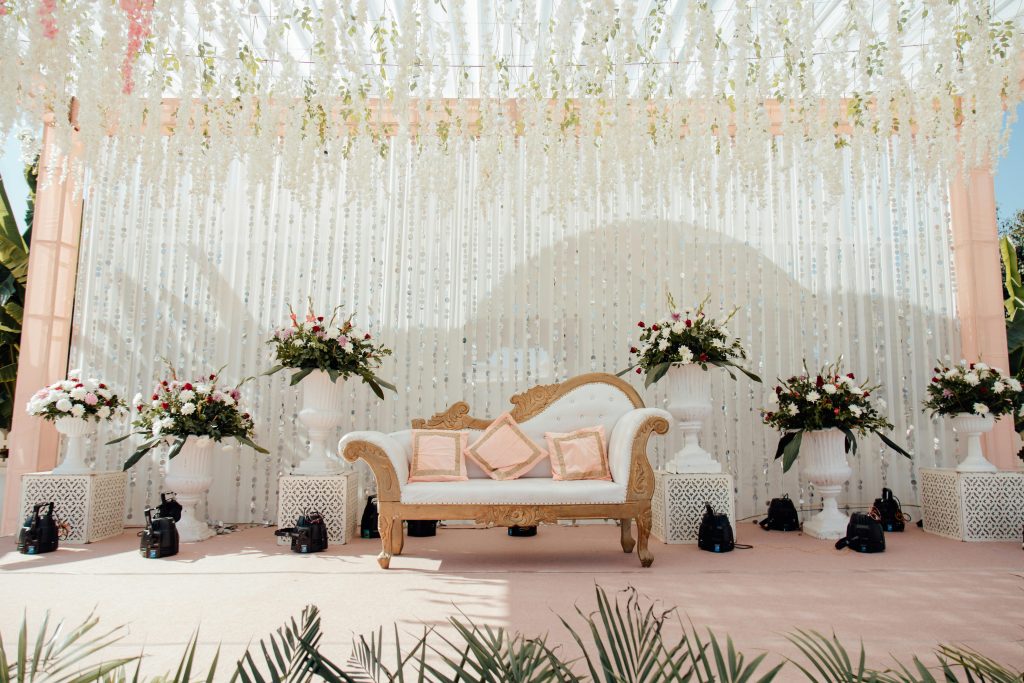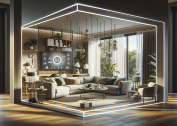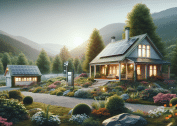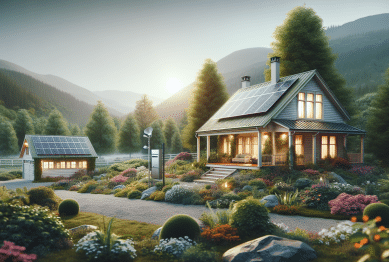In 2025, the concept of outdoor living has evolved beyond mere aesthetics; it’s about creating sanctuaries that offer seclusion, comfort, and a seamless blend with nature. As urbanization increases and personal space becomes more precious, homeowners are seeking ways to design outdoor areas that feel private and intimate. This article explores the current trends and practical strategies for achieving privacy in your outdoor spaces.

The Growing Importance of Outdoor Privacy
The need for private outdoor spaces is driven by several factors:
- Urbanization: In densely populated areas, such as Kyiv, limited space and close proximity to neighbors make privacy a luxury.
- Mental Health: Personal retreats in nature have been shown to reduce stress and enhance mental health.
- Multifunctionality: With more people working from home, outdoor spaces serve as extensions of living areas, requiring both functionality and seclusion.
Creating a private outdoor space allows individuals to enjoy nature, entertain guests, or find solitude without the intrusion of external elements.
Emerging Trends in Private Outdoor Design
1. Vertical Gardens and Green Walls
Vertical gardens are gaining popularity as effective privacy solutions, especially in urban settings where ground space is limited. These installations not only provide seclusion but also contribute to environmental sustainability by improving air quality and reducing noise pollution. Incorporating native plants into these designs can further enhance their ecological benefits.
Benefits:
- Space Efficiency: Ideal for small yards or urban environments.
- Environmental Impact: Improves air quality and reduces noise.
- Aesthetic Appeal: Adds greenery and visual interest.
Implementation Tips:
- Choose Appropriate Plants: Select plants that thrive in your climate and require minimal maintenance.
- Use Sustainable Materials: Opt for eco-friendly materials for the structure and planters.
- Ensure Proper Irrigation: Implement a drip irrigation system to maintain plant health.
2. Modular and Flexible Furniture
Modular outdoor furniture allows homeowners to adapt their spaces for various activities, from intimate gatherings to larger social events. This flexibility is essential for creating multifunctional outdoor areas that cater to different needs while maintaining a sense of privacy.
Benefits:
- Adaptability: Easily rearrange furniture to suit different occasions.
- Storage Solutions: Many modular pieces offer built-in storage options.
- Durability: Designed to withstand outdoor conditions.
Implementation Tips:
- Select Weather-Resistant Materials: Choose furniture made from materials like teak, aluminum, or weather-resistant wicker.
- Incorporate Cushions and Throws: Add comfort and style with outdoor cushions and throws.
- Consider Scale: Ensure the furniture size is proportionate to your outdoor space.
3. Smart Landscaping and Lighting
Integrating technology into outdoor design can enhance both functionality and privacy. Smart lighting systems can be programmed to adjust brightness and color, creating ambiance and deterring unwanted attention. Additionally, automated irrigation systems ensure that plants thrive, contributing to the overall seclusion of the space.
Benefits:
- Energy Efficiency: Smart systems can reduce energy consumption.
- Enhanced Security: Motion-sensor lighting can deter intruders.
- Convenience: Automation simplifies maintenance tasks.
Implementation Tips:
- Install Motion Sensors: Place sensors in strategic locations to enhance security.
- Use LED Lighting: Opt for energy-efficient LED lights.
- Automate Irrigation: Set up timers or smart controllers for watering plants.
4. Natural and Sustainable Materials
The use of natural materials such as wood, stone, and bamboo not only adds aesthetic value but also blends seamlessly with the environment. These materials are often more sustainable and contribute to the creation of a tranquil, private outdoor setting.
Benefits:
- Eco-Friendly: Sustainable materials have a lower environmental impact.
- Timeless Aesthetic: Natural materials offer a classic and enduring look.
- Durability: Many natural materials are long-lasting and require minimal maintenance.
Implementation Tips:
- Source Responsibly: Ensure materials are sourced sustainably.
- Combine Textures: Mix different materials for visual interest.
- Maintain Regularly: Proper care can extend the lifespan of natural materials.
5. Incorporation of Water Features
Water features like fountains, ponds, and streams can serve as both decorative elements and privacy enhancers. The sound of flowing water masks background noise, creating a serene atmosphere that feels secluded from the outside world.
Benefits:
- Noise Reduction: Masks unwanted sounds from the surrounding environment.
- Aesthetic Value: Adds visual and auditory interest to the space.
- Wildlife Attraction: Can attract birds and other wildlife, enhancing the natural feel.
Implementation Tips:
- Select Appropriate Features: Choose water features that suit your space and style.
- Ensure Proper Maintenance: Regular cleaning and maintenance are essential.
- Consider Placement: Position features where they can be enjoyed without obstructing pathways.
Practical Tips for Designing Private Outdoor Spaces
1. Assess Your Space
Begin by evaluating your outdoor area. Consider factors such as size, shape, orientation, and existing structures. Identifying these elements will help in planning the layout and selecting appropriate privacy solutions.
Steps:
- Measure Dimensions: Accurately measure the area to understand its size.
- Identify Viewpoints: Determine where privacy is most needed.
- Consider Sunlight: Note areas that receive direct sunlight and those that are shaded.
2. Create Zones
Divide your outdoor space into distinct zones for different activities, such as dining, lounging, and gardening. Use elements like trellises, hedges, or furniture arrangements to delineate these areas, enhancing both functionality and privacy.
Steps:
- Define Purposes: Decide what activities each zone will accommodate.
- Use Dividers: Implement physical barriers like screens or plants.
- Maintain Flow: Ensure there is a natural flow between zones.
3. Incorporate Greenery
Planting trees, shrubs, and climbing plants can provide natural barriers that shield your space from prying eyes. Opt for dense foliage and consider the growth patterns of plants to ensure long-term privacy.
Steps:
- Select Appropriate Plants: Choose plants that suit your climate and space.
- Plan for Growth: Consider the mature size of plants.
- Group Plants Strategically: Cluster plants to create dense coverage.
4. Use Screening Materials
Install screens made of materials like bamboo, fabric, or metal to block views from neighboring properties. These can be placed strategically around the perimeter or in specific areas where privacy is most needed.
Steps:
- Choose Suitable Materials: Select materials that complement your design.
- Ensure Stability: Secure screens properly to withstand weather conditions.
- Combine with Greenery: Enhance screens with climbing plants or vines.
5. Add Personal Touches
Incorporate elements that reflect your personal style, such as decorative planters, sculptures, or lighting fixtures. These additions not only enhance the aesthetic appeal but also make the space feel uniquely yours.
Steps:
- Select Meaningful Items: Choose decorations that resonate with you.
- Balance Aesthetics: Ensure additions complement the overall design.
- Consider Functionality: Opt for items that serve both decorative and practical purposes.
Conclusion
Designing outdoor spaces that feel private is more than just a trend; it’s a response to the evolving needs of homeowners seeking sanctuary in their own backyards. By embracing current design trends and implementing practical strategies, you can transform your outdoor area into a private haven that caters to relaxation, wellness, and personal enjoyment.
References:
- AA Landscaping. (2025). Top 10 Spring Landscaping Trends for 2025. Retrieved from https://www.aaflandscaping.com/top-10-spring-landscaping-trends-for-2025
- Obrien Landscape. (2025). 5 Landscape Design Trends for 2025. Retrieved from https://www.obrienlandscape.com/blog/5-landscape-design-trends-for-2025
- Precision Landscaping. (2025). Top 5 Landscaping Trends in Cleveland for 2025. Retrieved from https://www.precisioncorporation.com/blog/top-5-landscaping-trends-in-cleveland-for-2025









